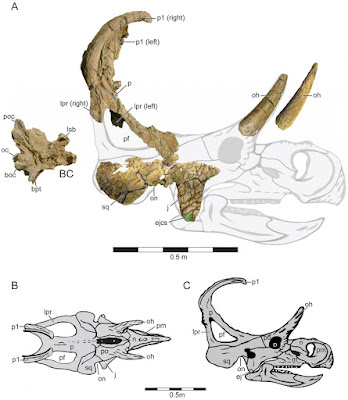Abstract
The Upper Cretaceous (middle-late Campanian) Wahweap Formation of southern Utah contains the oldest diagnostic evidence of ceratopsids (to date, all centrosaurines) in North America, with a number of specimens recovered from throughout a unit that spans between 81 and 77 Ma. Only a single specimen has been formally named, Diabloceratops eatoni, from the lower middle member of the formation. Machairoceratops cronusi gen. et sp. nov., a new centrosaurine ceratopsid from the upper member of the Wahweap Formation, is here described based on cranial material representing a single individual recovered from a calcareous mudstone. The specimen consists of two curved and elongate orbital horncores, a left jugal, a nearly complete, slightly deformed braincase, the left squamosal, and a mostly complete parietal ornamented by posteriorly projected, anterodorsally curved, elongate spikes on either side of a midline embayment. The fan-shaped, stepped-squamosal is diagnostic of Centrosaurinae, however, this element differs from the rectangular squamosal in Diabloceratops. Machairoceratops also differs in the possession of two anterodorsally (rather than laterally) curved epiparietal ornamentations on either side of a midline embayment that are distinguished by a posteromedially-oriented sulcus along the entire length of the epiparietal. Additionally, the parietosquamosal frill is lacking any other epiossifications along its periphery. Machairoceratops shares a triangular (rather than round) frill and spike-like epiparietal loci (p1) ornamentation with the stratigraphically lower Diabloceratops. Both parsimony and Bayesian phylogenetic analyses place Machairoceratops as an early-branching centrosaurine. However, the parsimony-based analysis provides little resolution for the position of the new taxon, placing it in an unresolved polytomy with Diabloceratops. The resultant Bayesian topology yielded better resolution, aligning Machairoceratops as the definitive sister taxon to a clade formed by Diabloceratops and Albertaceratops. Considered together, both phylogenetic methods unequivocally place Machairoceratops as an early-branching centrosaurine, and given the biostratigraphic position of Machairoceratops, these details increase the known ceratopsid diversity from both the Wahweap Formation and the southern portion of Laramidia. Finally, the unique morphology of the parietal ornamentation highlights the evolutionary disparity of frill ornamentation near the base of Centrosaurinae.
Systematic Paleontology
Systematic hierarchy.
Ornithischia Seeley, 1887 [42] sensu Sereno 1998 [43]
Ceratopsia Marsh, 1890 [44] sensu Dodson 1997 [45]
Ceratopsidae Marsh, 1888 [46] sensu Sereno 1998 [43]
Centrosaurinae Lambe, 1915 [31] sensu Dodson et al., 2004 [37]
Machairoceratops gen. nov.
urn:lsid:zoobank.org:act: F8351E74-0476-425F-AC6A-04C57CFC8AA1
Machairoceratops cronusi, gen. et. sp. nov.
urn:lsid:zoobank.org:act: F1863F1B-4151-4B06-A1E4-9808A2CF2A9
Holotype: The holotype specimen is UMNH VP 20550, an associated partial skull including two curved and elongate orbital horncores, left jugal, nearly complete, slightly deformed braincase, left squamosal, and a parietal complex ornamented by caudally projecting, rostrally curved, elongate spikes on either side of a midline embayment. All material is reposited at the Natural History Museum of Utah, Salt Lake City, Utah, United States of America.
Type, locality, horizon and age: Grand Staircase-Escalante National Monument (GSENM), Kane County, southern Utah, U.S.A. Stratigraphically, Machairoceratops occurs within the upper member (~200–350 m) of the late Campanian Wahweap Formation, which is currently dated between ~80.1–77 Ma (Fig 2) [2, 3].
Etymology: Machairoceratops, from machairis (Greek), bent sword, in reference to the posterodorsally projecting, anteriorly curved epiparietal (locus p1) ornamentation, and ceratops (Latinized Greek), horned-face. The specific epithet cronusi refers to the Greek god Cronus who, according to mythology, deposed his father Uranus with a sickle or scythe, and as such is depicted carrying a curved bladed weapon.
Diagnosis: Centrosaurine ceratopsid diagnosed by the following autapomorphies: posteriorly projecting, anteriorly curved spike-like epiparietal loci (p1) ornamentation, that also exhibits a posteromedially directed sulcus along the entire length of the epiparietal differing from all other sulci present on ceratopsian epiossifications in width, depth, and overall conformation. Machairoceratops differs from the stratigraphically lower Diabloceratops in a number of key features including: a fan-shaped, subrectangular (rather than rectangular) stepped squamosal, an inferred (based on size and shape of the epijugal contact facet) smaller, elliptical (rather than tetrahedral) epijugal, two anterodorsally (rather than laterally) curved (p1) epiparietals on either side of a midline embayment, and a posteromedially oriented sulcus running the entire length of the posterior surface of the epiparietal loci (p1) ornamentation. Additionally, Machairoceratops differs from several roughly contemporaneous centrosaurines from the northern portion of Laramidia (e.g., Albertaceratops nesmoi, Coronosaurus brinkmani, and Spinops sternbergorum) in possessing a triangular (rather than rounded) parietosquamosal frill, and in the morphology and orientation of the epiparietal ornamentation as described above.
 |
| An artist's interpretation of Machairoceratops cronusi, a newly identified horned dinosaur discovered in southern Utah.
illustration: Mark Witton
|
Conclusions
New ceratopsian dinosaur material (UMNH VP 20550) recovered from the upper member of the Wahweap Formation is here used to erect a new taxon, Machairoceratops cronusi gen. et sp. nov., which can be confidently placed as an early-branching centrosaurine established on both a parsimony-based analysis and a Bayesian analysis. One autapomorphic character of the new taxon (i.e., epiparietal (p1) ornamentation) expands known epiparietal disparity in ceratopsid dinosaurs. Considered together, the phylogenetic, stratigraphic, and morphologic evidence distinguishes Machairoceratops from all other centrosaurine dinosaurs, and increases the known ceratopsian diversity in the southern portion of Laramidia.
Eric K. Lund, Patrick M. O’Connor, Mark A. Loewen and Zubair A. Jinnah. 2016. A New Centrosaurine Ceratopsid, Machairoceratops cronusi gen et sp. nov., from the Upper Sand Member of the Wahweap Formation (Middle Campanian), Southern Utah. PLoS ONE. 11(5): e0154403. DOI: 10.1371/journal.pone.0154403
Paleontologists discover new species of horned dinosaur in southern Utah
http://phy.so/382799467 via @physorg_com
http://phy.so/382799467 via @physorg_com



